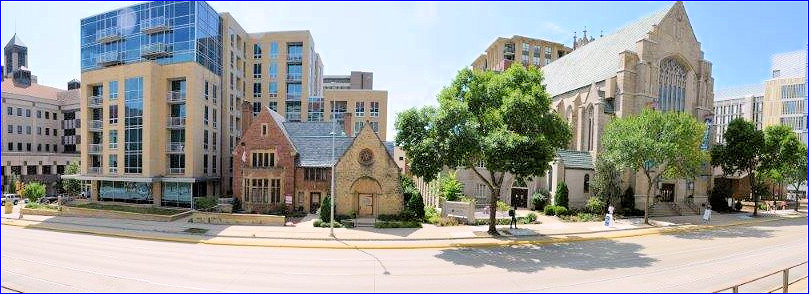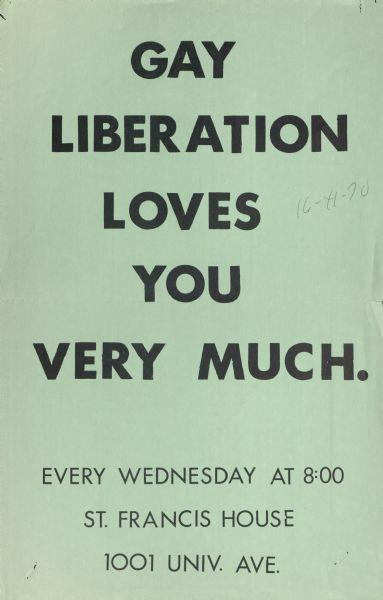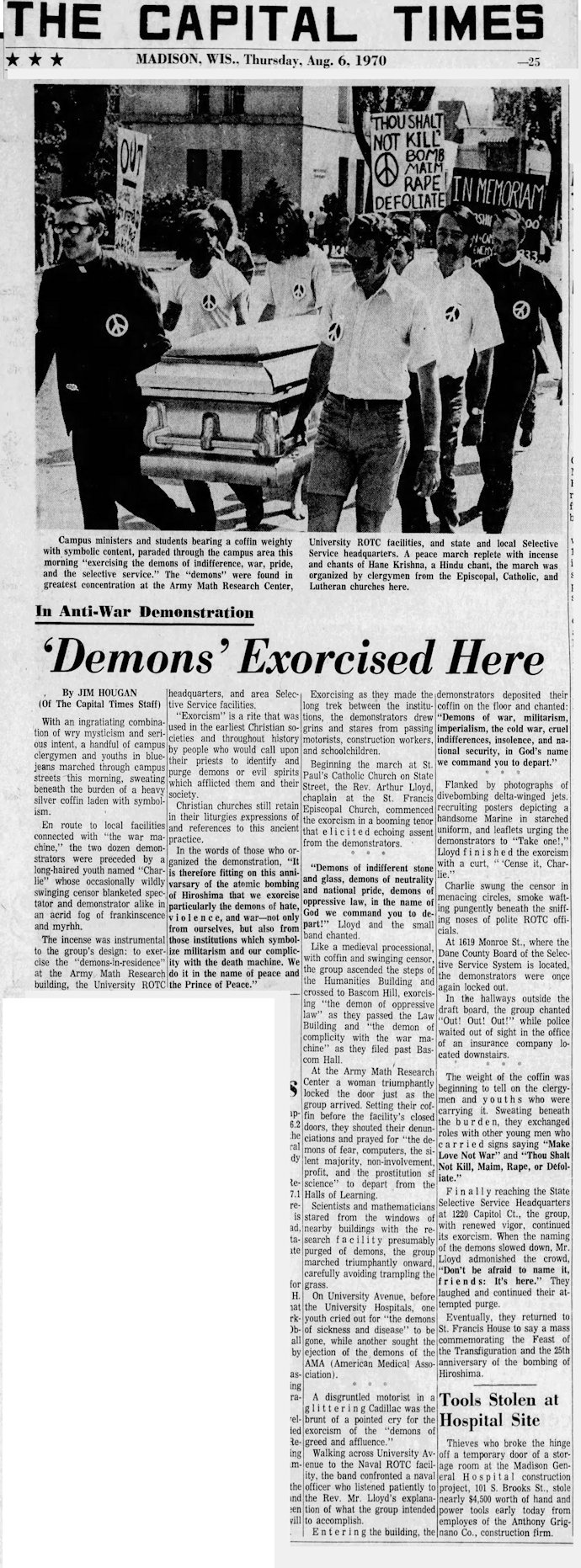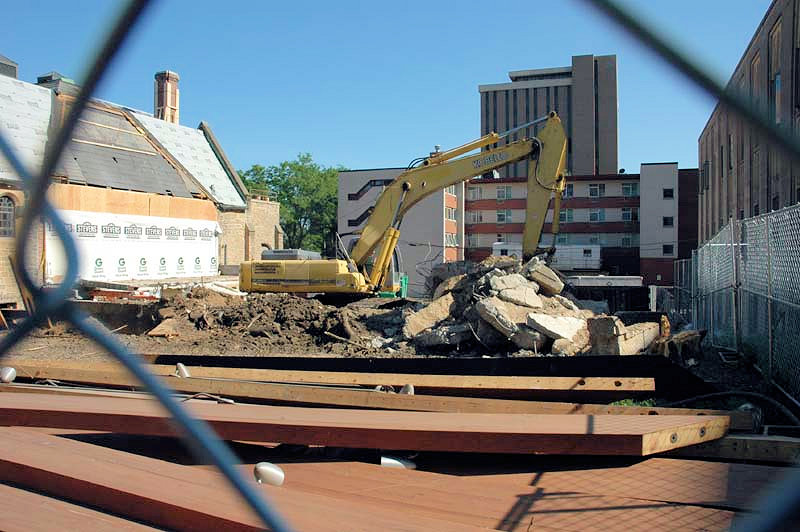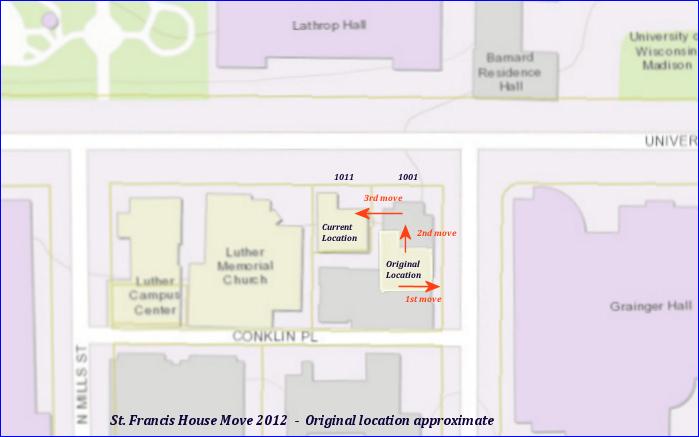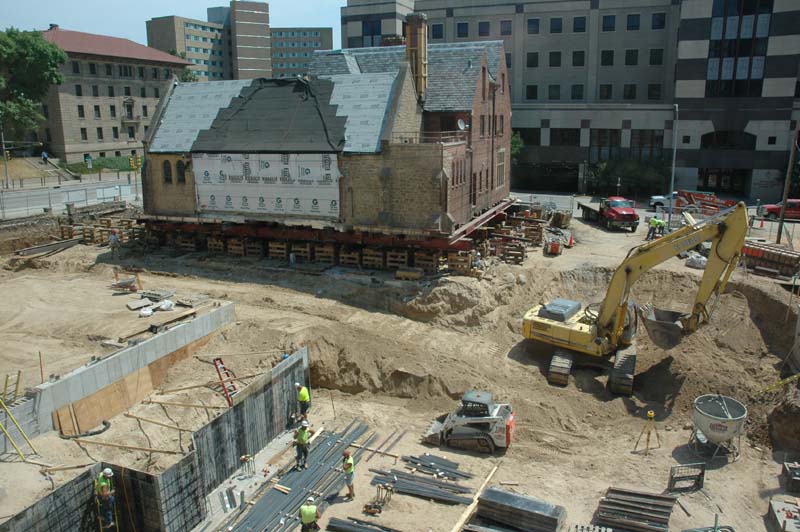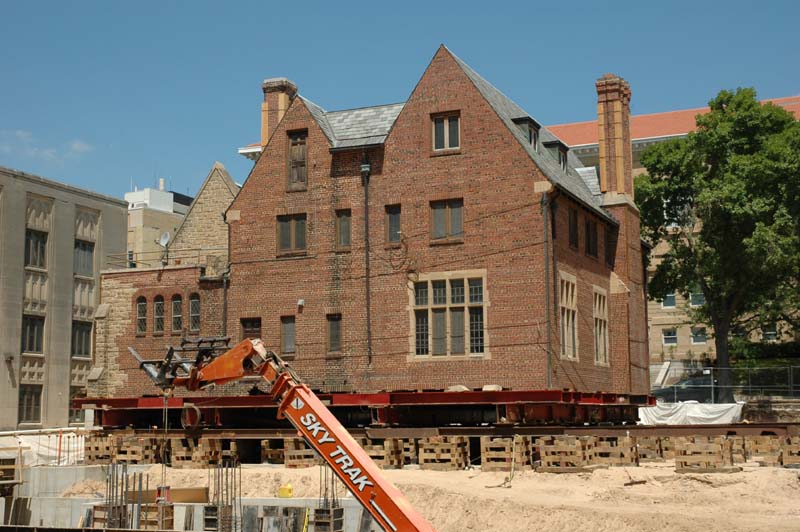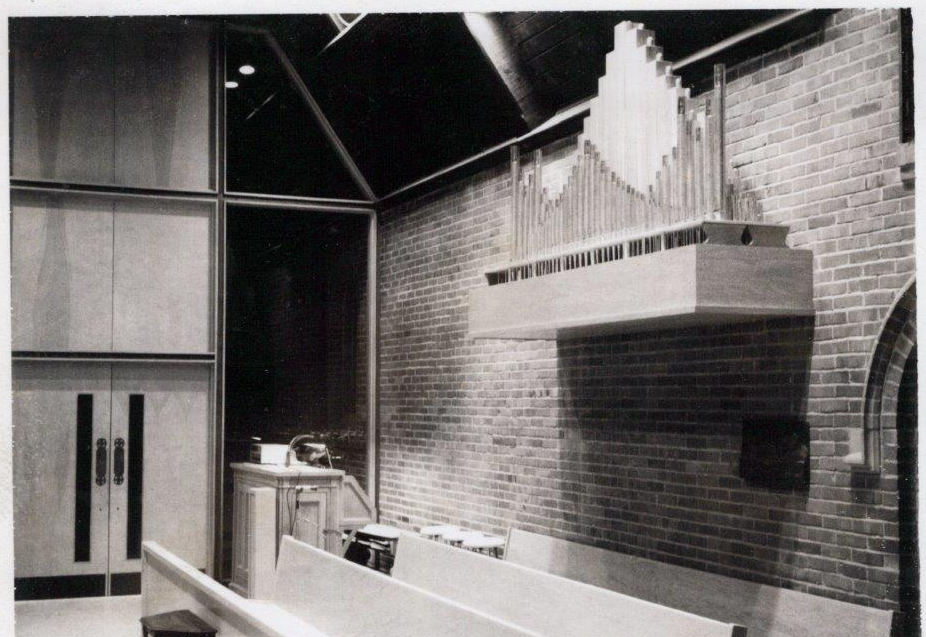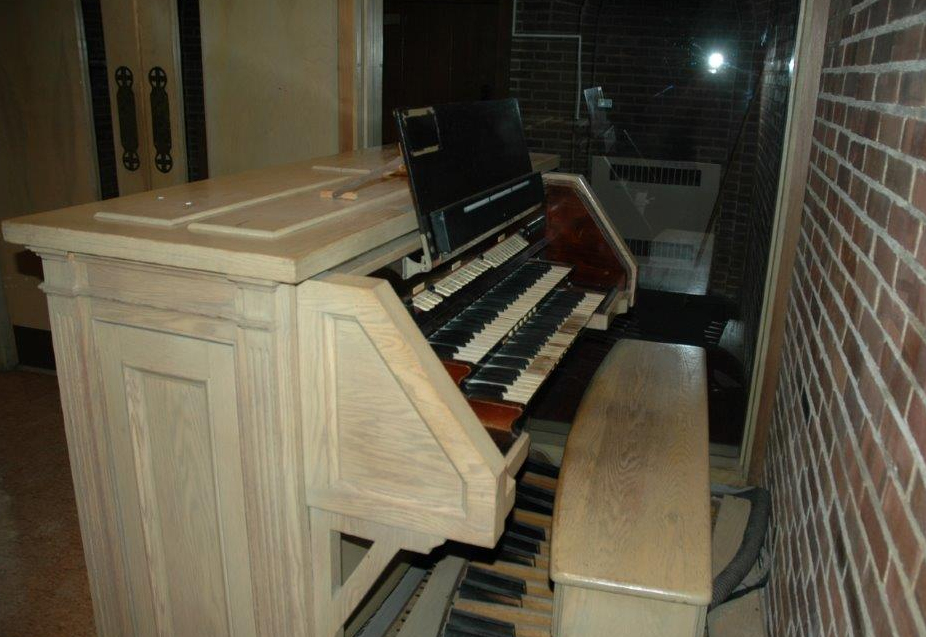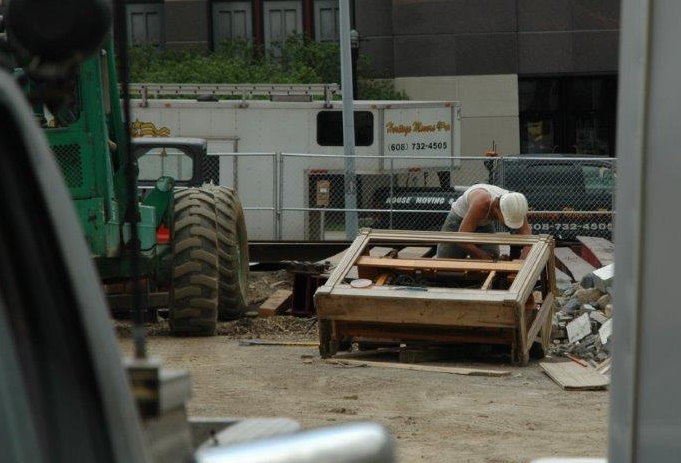St. Francis House
Madison, Wisconsin
Part Two
From 1964
Begun as a community of Episcopal Church students in 1915, and now over one hundred years old, this page continues the story from the first fifty years.
For Part One - The First Fifty Years - click here.
This History is an independent research project not affiliated with St. Francis House.
The History
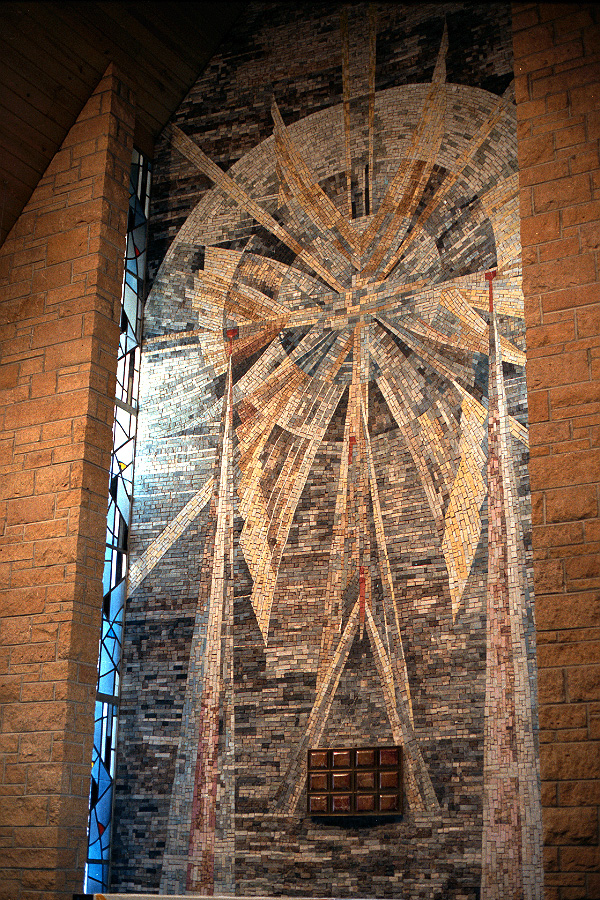
 As seen in Part One, the retirement of Fr. White was on the eve of the building of the new chapel attached to the west side of the existing House in 1964. Contracts for the new chapel were let June 30, 1964. In the same paper it was announced that Fr. Paul K. Abel would be taking over the reins of the chaplaincy. Fr. Abel, when he saw the plans for the new chapel, he was amazed that nothing had been done about updating the organ. In consultation with local organ builder, H. Frederick Fuller, an updated design was formulated. The new chapel was opened for business December 5th of the same year while finishing touches, like the pews, had yet to be installed. The mosaic from Germany, held up by a strike by longshoremen, wouldn’t be installed until 1965, nor would the relocated organ. (Footnote:
1) Organ updated: Bill Mueller, email 8/29/2021. 2)Mosaic and organ installed 1965: Bill Mueller, email 9/6/2021;
) While services were held, the new church wouldn’t be dedicated and consecrated by Bishop Hallock until March 13, 1965. (Footnote:
Order of Service Bulletin, “Secularization of St. Francis Church,” March 10, 2012.
) St. Dunstan’s Episcopal church, five miles west on University Ave., had been dedicated just months before with Fr. Abel preaching.
(Footnote:
1) “First Service in St. Francis Chapel Set”, Wisconsin State Journal, hereafter WSJ, 5 Dec 1964, Section 1, page 4; 2) “St. Dunstan Church Dedicated on Sunday,” WSJ, 19 Sep 1964, Section 1, page 1. )
As seen in Part One, the retirement of Fr. White was on the eve of the building of the new chapel attached to the west side of the existing House in 1964. Contracts for the new chapel were let June 30, 1964. In the same paper it was announced that Fr. Paul K. Abel would be taking over the reins of the chaplaincy. Fr. Abel, when he saw the plans for the new chapel, he was amazed that nothing had been done about updating the organ. In consultation with local organ builder, H. Frederick Fuller, an updated design was formulated. The new chapel was opened for business December 5th of the same year while finishing touches, like the pews, had yet to be installed. The mosaic from Germany, held up by a strike by longshoremen, wouldn’t be installed until 1965, nor would the relocated organ. (Footnote:
1) Organ updated: Bill Mueller, email 8/29/2021. 2)Mosaic and organ installed 1965: Bill Mueller, email 9/6/2021;
) While services were held, the new church wouldn’t be dedicated and consecrated by Bishop Hallock until March 13, 1965. (Footnote:
Order of Service Bulletin, “Secularization of St. Francis Church,” March 10, 2012.
) St. Dunstan’s Episcopal church, five miles west on University Ave., had been dedicated just months before with Fr. Abel preaching.
(Footnote:
1) “First Service in St. Francis Chapel Set”, Wisconsin State Journal, hereafter WSJ, 5 Dec 1964, Section 1, page 4; 2) “St. Dunstan Church Dedicated on Sunday,” WSJ, 19 Sep 1964, Section 1, page 1. )
Under Fr. Abel as chaplain, services continued as 8 and 10 a.m. on Sundays with Evensong at 5:30. Fr. Abel invited guest lecturers and was a fan of services with folk music; the Wisconsin State Journal reported December of 1967 that SFH “holds folk services frequently, and each time the services are packed.” (Footnote: “Seminary Students Change Image – Folk Mass Gaining in Popularity” WSJ, 9 Dec 1967, page 11. ) He and Mrs. Otto did not get along all that well, and the sixty-nine-year-old housemother retired at the end of the 1964-65 academic year to be replaced by the Rev. Claud Thompson in the apartment on the second floor of SFH in 1966. He remained until his marriage September 1, 1968. Fr. Thompson was working a Ph.D. in English and celebrated the Eucharist services in the interim between Fr. Abel’s retirement (Footnote: In the services notices in the WSJ he is named as holding the services, but in a note in the March 23, 1967 Capital Times he is referred to as “formerly priest-in-charge of St. Francis House…Recently resigned” - Capital Times, 23 Mar 1968, page 4, Col 5 under “Grace Church” where he was preaching at both services, AND holding services at SFH. He couldn’t have been in two places at the same time. ) in the early spring of 1968 and the hiring of Fr. Lloyd in June.Another priest who filled in and helped around the House was the Rev. John Denny Fischer, a musician and student of English. There is a good biography of him on his Find-a-Grave memorial.
Social and political activism came to St. Francis House with the arrival of forty-one-year-old the Rev. Arthur Lloyd in the summer of 1968. Fr. Lloyd, fresh from six years as chaplain to students at Indiana University in Bloomington and twelve years a priest wasted little time. When the newly formed Madison Alliance for Homosexual Equality (MAHE) was unable to meet anywhere in the city, Fr. Lloyd accepted their request to meet at the House. (Footnote: MAHE at SFH: 1) Personal experience; 2) “City of Madison, Wisconsin Underrepresented Communities Historic Resource Survey Report” (City of Madison, 2017-2020), online at https://tinyurl.com/yfxv3hs4; 3) Capital Times, 30 April, 1970, page 12. ) Changing its name to the Gay Liberation Front, it continued to meet in the basement “rec room.”
A popular, if rather enigmatic figure at the House during this time and into the 1970s was Fr. Wandile Kuse, a South African priest who spoke frequently around the city and area on apartheid and intrigued folks by occasionally speaking his native Xhosa “click” language; he was studying its literature. He filled in on services at SFH and around Madison living for one year in the small bedroom on the second floor. He received his MA in 1972 and completed a Ph.D. from U of Wisconsin in 1978. Returning to South Africa he became a noted professor. His Worldcat Identity notes 9 works in 26 publications as editor, translator, or author.
The same month that MAHE began meeting at the House, anti-war protests and teach-ins proliferated around the campus and the country. October 15, 1969 was the first Moratorium to End the War in Vietnam and march on Washington; the Capital Times, in an article on those teach-ins reported “An unusual interfaith service was under way this morning at St. Francis House, 1001 University Ave., the Episcopal student center. Lowell Fuwster of the Baptist Campus Ministry, and the Rev. Ed Beers of the United Church of Christ Campus Ministry, standing on opposite side of the church, took turns reading accounts of the war from various newspapers and periodicals, interspersing their litany with the words, ‘Lord have mercy.’” (Footnote: “Jam-Packed Teach-ins Mark Protest Here”, Capital Times, 15 Oct 1969, page 49. )
The war, and the protests were escalating. In November nine regulars of St. Francis House bordered a VW mini-bus to make the trip to Washington as part of the National Mobilization by the Committee to End the War in Vietnam, the second Moratorium of that fall. (Footnote:
Mini-bus trip to Washington: Personal experience. I was one of the nine; it was my vehicle. One of the SFH regulars, Chris Beck, has this blurry memory: "Strange tidbits I remember: the driver’s door came off the bus while we were getting ready to leave. I can’t remember what happened or how you fixed it. We had a blowout on the freeway outside of Chicago, which you handled incredibly well. We stayed at a church in DC — must have been either Episcopal or RC because I remember trying to sleep on the kneeler. (??) Maybe the pews had dividers so they were too short to lie down? Somebody stole my wallet and everyone else on the bus chipped in to buy food for me on the way home. Other than those rather odd memories, much of what happened was a blur. We were too far from any stages to see much/hear much, and we marched along the sidewalk past the White House in a drizzling rain, so it was all quite somber.
) (Footnote:
The October event corresponded with the first Moratorium to End the War. The November event saw some 600,000 people descend on Washington. The Wikipedia article on the second one is at https://en.wikipedia.org/wiki/Moratorium_to_End_the_War_in_Vietnam
) Six months later, in the wake of the killings at Kent State on May 4, 1970 which followed increased bombings of North Vietnam and the invasion of Cambodia, all hell broke loose on campuses across the country, and Madison was no exception. St. Francis House found itself in the middle of tear gas during several days of riots as a "safe house" and medical center; a huge red cross was posted on the front door. The May 7th Capital Times reported that over 300 people were treated at the House the previous night.
 A week later a basement room in the chapel was designated for collection of draft cards, and it wasn’t soon after that telephones were brought in and a draft counselling center was set up that continued for several years.
A week later a basement room in the chapel was designated for collection of draft cards, and it wasn’t soon after that telephones were brought in and a draft counselling center was set up that continued for several years.
Later that year, on August 6, 1970, the anniversary of the bombing of Hiroshima, Fr. Lloyd organized, along with other clergy, an Exorcism of, in the words of Fr. Lloyd, “Demons of indifferent stone and glass, demons of neutrality and national pride, demons of oppressive law, in the name of God we command you to depart!” It was part of ongoing objections on campuses around the country to universities participating in military weapons research, and the object in this case was, among other sites, Sterling Hall which housed the Army Math Research Center on campus. At the same time, four men were planning the bombing of Sterling Hall which occurred eighteen days later killing one researcher.
At the 100 anniversary of SFH in 2015 the late Charley Taylor reflects on this in a YouTube video.
Exorcism clip from the 1980 Oscar nominated
documentary 'The War at Home'.
While the anti-war activity raged, Broom Street Theater (BST) performed its first production,The Junk Show, at SFH in the chapel in October of 1970. (Contrary to the Wikipedia article on BST, the performances were not in the basement, but in the chapel, and it was members of the vestry who objected to a scene in the summer of 1974 production of Song of Bernadette and spelled the end of BST's welcome.)
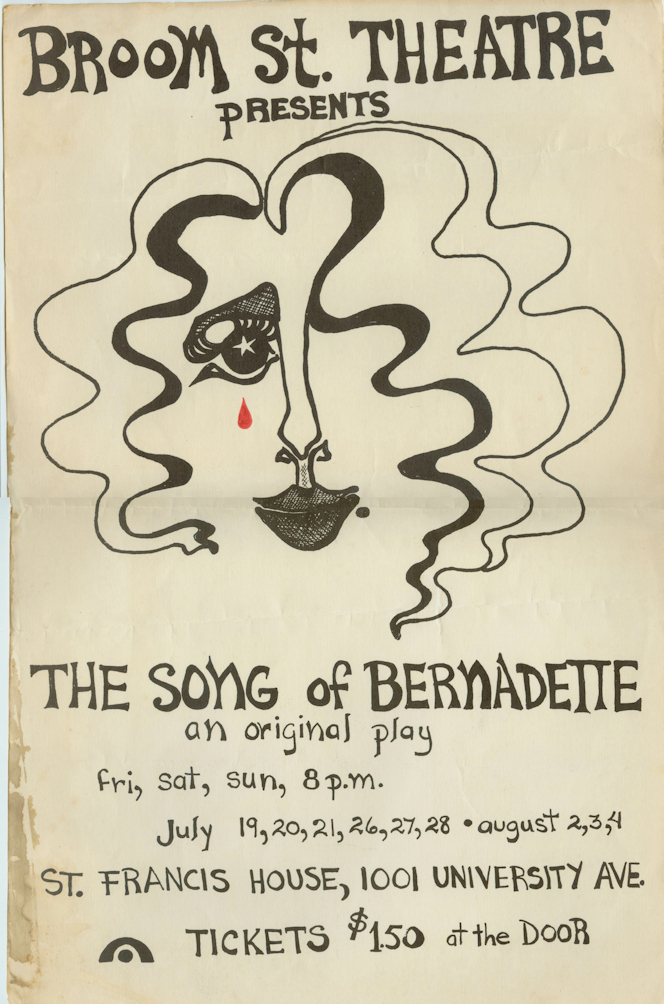 Two more performances after Song were performed in the chapel, the last being a revival of The Good Woman of Mazomanie in February of 1975.) (Footnote:
The information about the basement and the bishop's objection came from Dan Levin’s excellent 2012 documentary “Filthy Theater” in which are some interviews with persons several decades later who were not there in the 1970s but relied on hearsay. I was present at the time, performed in several plays and built sets as well. It was during Song of Bernadette that I met my wife to be, Cara McManis, who was the Virgin Mary in the play. “Filthy Theater” is now on Vimeo: https://vimeo.com/52300037
) The controversial theater’s production of Lysistrata in May of 1969 and the departure of its founder left BST with no permanent home and no venue would touch it. Joel Gersmann, the artistic director, approached Fr. Lloyd about using the chapel for rehearsals and performances and he agreed. After five years and the objections engendered by Song of Bernadette, the vestry gave Gersmann a grace period to find a new location, which they did on the east side of Madison; BST is still going strong. (Footnote:
BST’s website is https://bstonline.org/
) Click here to see a complete list of Broom Street's performances at St. Francis House.
Two more performances after Song were performed in the chapel, the last being a revival of The Good Woman of Mazomanie in February of 1975.) (Footnote:
The information about the basement and the bishop's objection came from Dan Levin’s excellent 2012 documentary “Filthy Theater” in which are some interviews with persons several decades later who were not there in the 1970s but relied on hearsay. I was present at the time, performed in several plays and built sets as well. It was during Song of Bernadette that I met my wife to be, Cara McManis, who was the Virgin Mary in the play. “Filthy Theater” is now on Vimeo: https://vimeo.com/52300037
) The controversial theater’s production of Lysistrata in May of 1969 and the departure of its founder left BST with no permanent home and no venue would touch it. Joel Gersmann, the artistic director, approached Fr. Lloyd about using the chapel for rehearsals and performances and he agreed. After five years and the objections engendered by Song of Bernadette, the vestry gave Gersmann a grace period to find a new location, which they did on the east side of Madison; BST is still going strong. (Footnote:
BST’s website is https://bstonline.org/
) Click here to see a complete list of Broom Street's performances at St. Francis House.
Father Lloyd retired as chaplain in 1977, moving on to other causes, but the activism remained as a feature of the House’s ministry. Indeed, in 1983, along with Fr. Lloyd and other chaplains who had been highlighting the plight of Central American refugees, Fr. Woodward and the congregation offered sanctuary in St. Francis House to some of those who had fled. St. Francis House became the first congregation in Madison to give refugees from the war in El Salvador a home, against the will of the U.S. Immigration Service. (Footnote: “Salvador refugees find sanctuary,” WSJ 24 May 1983 Section 4, page 1 with picture https://www.newspapers.com/image/404687853 ) Father Woodward had been announced as the new chaplain in October of 1977, (Footnote: “Welcome new chaplain at St. Francis House,” Capital Times, 15 Oct 1977, page 14. An outdoor service on the State Street Mall presided over by Bishop of Milwaukee Charles Gaskell. ) a post he held for eleven years. In an article about the magic tricks and mime he would use around campus the author described him as one who “isn’t afraid to thrust flames dramatically down his throat if it will bring home a point to his parishioners.” (Footnote: “Clowning around religiously,” Capital Times, 29 Oct 1983, page 1. With picture of him eating fire. )
The sanctuary service was documented in this half-hour film, "The New Underground Railroad" from Carl Hersh on Vimeo.
The Rev. Woodward’s leaving for Salinas, California was announced in the papers in August of 1988 to take up a new post in Salinas, California at St. Paul’s. (Footnote: 1) Capital Times, 17 August 1988, page 2; “St. Paul’s Episcopal Church welcomes new rector,” 2) The Californian (Salinas, CA) 3 Sept 1988, page 6B. ) When the Rev. Virginia Lund was installed as chaplain in September of 1991 the Wisconsin State Journal noted that she had been “associate chaplain” since 1988. She brought an ecumenical spirit to the House; worship notices in the paper advertised 10 am Sunday worship, “St. Francis House University Episcopal Center - Inclusive Worship Community – Student Coop – Ecumenical & Interfaith – UW campus ministry.” She brought something else, a fervent concern for abused women and feminism. In an article in the Wisconsin State Journal about abuse and incest she stated that she came to feminism in seminary and realized that after years as a “righteous social activist, I was always going to save them – people of color, Nicaraguans, that other group. I could never admit to my own victimization. I thought that by saving someone else, I could indirectly save myself, but you can’t do that until you admit what happened to you – and get good and angry about it.” (Footnote: “Surviving our lives”, WSJ 30 May 1993, Page 4D continued from Page 1D. https://www.newspapers.com/image/406413185/ )
The Rev. Lund left in the summer of 2003 to be replaced by the Rev. Melissa Wilcox, at which point the tenor of the advertisements in the paper changed to “Holy Eucharist Wednesday at 12 Noon and Sunday at 5 PM. Worshiping community serving the students, faculty and staff at the University of Wisconsin-Madison.” Indeed, Melissa, in her words, “moved the House from being a housing co-op to an Episcopal Campus ministry. I reinstated an Episcopal liturgy after many years with none.” (Footnote: Rev. Melissa Wilcox, email, 8/24/2021. )
In short order following the leaving of the Rev. Lund, the Rev. Shannon Kelly was appointed chaplain. Priested seven years earlier she came to Madison with her husband, the Rev. Thomas Ferguson who followed her service as an interim chaplain. He saw through the initial plans to demolish the 1964 chapel and move the original house to the west to make room for an apartment building. Financial support for the campus ministry had dwindled in the Diocese and in May of 2011 a proposal to build a 12-story, 90-unit apartment building was presented to the Madison Plan Commission. That hit a snag with the objections of Luther Memorial next door that the height of the apartment building would cast a shadow diminishing the value of its stained-glass windows. After several months of debate, an 8-story apartment building proposal was accepted by the Madison City Council by a vote of 15-4 paving the way for the move of the House. (Footnote: 1)Rev.Tom Ferguson, email, 8/28/2021; 2) “Council OKs St Francis project,” WSJ, 22 Sep 2011, page A3. https://www.newspapers.com/image/523113500/ )
The Chaplains
The following are brief biographies of chaplains of St. Francis House from 1964 to the present. In most cases, additional biographical information can be found on their Find-a-Grave memorials or the web pages of their current parishes. Those links are in these biographies. With any luck and the help of others, this page will be updated with portrait pictures of the chaplains as they appeared when in service at the House.
The Rev. Paul Kramer Abel (1920-1977);
Chaplain 1964-1968
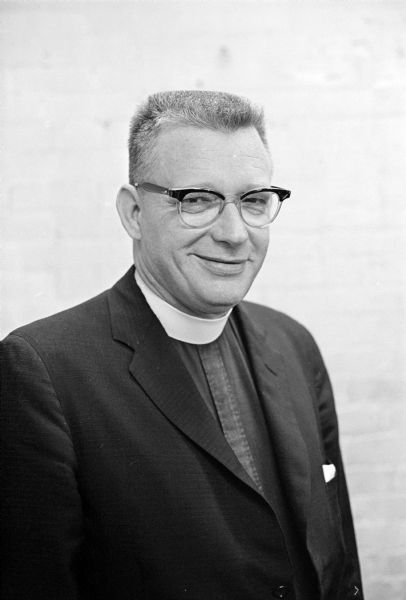
Fr. Abel came to St. Francis House from four years at Grace Episcopal church in Ocala, Florida. He assumed the chaplaincy in July of 1964 with the opening of the new chapel. Born in Pittsburgh, Pa. in 1920 the son of Albert and Elizabeth Abel, he graduated from Allegheny College, spent four years in the Air Corps during World War II, and graduated from Seabury-Western Seminary in 1948. Besides serving Grace church in Florida, he served parishes in Sycamore, Illinois and Hayes, Kansas. His full obituary posted on his Find-a-Grave memorial contains more information.

The Rev. Claud Adelbert Thompson (1933-2017);
Interim and assistant chaplain 1966-1968
Father Thompson, fresh from his graduation from Seabury-Western in 1964 and two years as a curate at All Saints in Appleton, Wisconsin, came to St. Francis House as a student/associate pastor in 1966 taking up the apartment on the second floor of the House. Born in Milwaukee, he graduated from Ripon College in 1955, received an M.A. in English Literature from Columbia University in New York. His specialty was the literature of John Milton. Married at the House in August of 1968, he received his Ph.D. in 1971 from the University of Wisconsin. A more complete biography is found at his Find-a-Grave memorial.

The Rev. Arthur Selden Lloyd (1927-2015);
Chaplain 1968-1977.
Born in Osaka, Japan the son of Episcopal missionaries the Rev. James Hubard and Louisa Myers Lloyd, Fr. Lloyd came to St. Francis House in September of 1968 following six years as chaplain at Indiana University. Educated at Hargrave Military Academy and the Virginia Episcopal School, he received a BA from the University of Virginia. His Master’s degrees in Theology were from Virginia Theological Seminary and Yale Divinity School. Very much the activist in local and national causes, his complete biography/obituary is at his Find-a-Grave memorial and includes much more about Fr. Lloyd.

Rev. Thomas B. Woodward;
Chaplain 1977-1988
Father Woodward came to St. Francis House in October of 1977 from a chaplaincy at the University of North Carolina in Chapel Hill. He was greeted in a special outdoor service on the State Street Mall which included folk music, a celebration of Holy Communion and a simple meal attended by Bishop Gaskell. The announcement in the Capital Times included “He has a broad range of interests, ranging from studies in theology and worship to his organization of Uncle Billy’s Pocket Circus, a small street circus which has played college campuses and street fairs, in which he served as a clown and mime…Greasepaint and juggling balls will also be presented with the words, ‘Be among us as clown, reflecting divine joy in the midst of a serious community.” He continued the activism of Fr. Lloyd, this time with the plight of refugees from the war in El Salvador as detailed more in the history text. Fr. Woodward left in 1988 for Salinas, California and is now retired in Santa Fe, New Mexico where he has written a blog since 2006: Turning Things Upside Down. (Accessed 8/3/2021)
The Rev. Virginia Sapienza Lund;
Associate Chaplain 1988-1991;
Chaplain Sept 1991-2003
The Rev. Lund was a graduate of the Episcopal Divinity School in Cambridge, Massachusetts and served in the Diocese of Michigan as a deacon at St. Gabriel’s Episcopal Church in East Detroit. She taught women’s liberation theology and ethics at the Whitaker School of Theology in Detroit. Priested in 1987 she evidently came to Madison shortly after and served as the associate chaplain, becoming installed as full chaplain in 1991, serving until 2003. She is now retired in Montana.
The Rev. Melissa Wilcox;
Chaplain 2003-2006
Ordained to the priesthood in February of 2001 in the Diocese of Connecticut, a fourth-generation Episcopal priest, but the first female to take Holy Orders in her family. She now serves as Associate Rector of St. John’s Episcopal church in Carlisle, Pennsylvania with her husband, the Rev. Adam Kradel. More information about both of them can be found at St. John's website. (Accessed 9/3/2021)
The Rev. Shannon Kelly;
Chaplain July 2006-March 2009
A native of Twin Falls, Idaho, where her mother was a deacon at Ascension Episcopal church, and a graduate of the Church Divinity School of the Pacific in Berkeley, California, Shannon was ordained to the priesthood in 1998. Shannon went on from St. Francis House to become Director of Christian Formation for the Diocese of Milwaukee in 2009 leaving her husband, the Rev. Tom Ferguson to shepherd through the decision-making process in moving the House. She is a published author, in 1998 revised 2013, of God of My Heart: A Prayer Book for Youth available on Amazon.com. She is now (September, 2021) Director of Faith Formation and Officer for Young Adult and Campus Ministries> on the staff of the Episcopal Church.
The Rev. Thomas Ferguson;
Chaplain March 2009-2011
As mentioned, Fr. Tom saw through the decision-making process of moving the House in 2011-12. He is presently rector of St. John’s in Sandwich, Massachusetts. This is part of his biography on that parish’s website: “Father Tom is a native of Hanson, Massachusetts, and attended Wesleyan University in Middletown, CT. He received his MDiv from Yale Divinity School, Master of Theology from Holy Cross Greek Orthodox School of Theology, and PhD in Church History from the Graduate Theological Union in Berkeley, California.” There is much more about Fr. Tom at St. John’s website. (Accessed 9/3/2021)
The Rev. Jonathan Melton;
Chaplain August, 2012-July, 2019
Ordained to the priesthood in 2007, Fr. Melton came to St. Francis House from St. Christopher’s by the Sea in Portland, Texas where he had been rector since October of 2009. He is a graduate of Wheaton College and Duke University Divinity School. Bringing social media skills to his ministry he published a blog, “Chasing Yoder,” now archived but continued as “the patience of trees” in 2013. He is now on the staff of Holy Trinity church in Heath, Texas. There is more about his time at St. Francis House in the text of the history as well as his very enlightening blog on his first four years at St. Francis House now in the archive of "The Patience of Trees."
The Rev. Donald Fleischman;
Chaplain 2019-2021
The rector of St. Luke’s Episcopal in Madison also served as chaplain to St. Francis House from Fr. Melton's leaving until the end of August, 2021 when a new chaplain took over the job.
The Rev. Roberta A. (Bobbi) Kraft;
Chaplain Sept 2021 – present
A native of Sheboygan and a 2018 graduate of Virginia Theological Seminary, Mother Bobbi was announced as the new chaplain in the September 3, 2021 Diocesan newsletter. The mother of two adult children, she came to SFH from Saint Barnabas the Encourager Episcopal church in Suamico, Wisconsin but prior to that had assisted at the Episcopal Student Center at Baylor University in Waco, Texas and served as chaplain to students at Georgetown University during her time at seminary. More information about her is in the Diocesan newsletter linked above.
Additional Links
This being the age of social media, one can keep up with the doings of St. Francis House on its Facebook Page.
There are hundreds of folks who came through the doors of St. Francis House over the decades. To memorialize some of them - now really those who I knew during my time at the House - I created some time ago a "Virtual Cemetery" on Find-a-Grave. Anyone wanting to add someone to that is welcome to email me (address at the bottom of this page) with a direct url to that person's memorial and I can add them to the Virtual Cemetery. All the deceased chaplains have memorials linked with their biographies. Find-a-Grave is free with ads. The Virtual Cemetery opens in a new tab at https://www.findagrave.com/virtual-cemetery/517587
In February of 2012 the chapel and House was emptied of appointments and in a Secularization Ceremony on March 10th the chapel was deconsecrated. The altar was moved to an outside location at St. Dunstan’s.
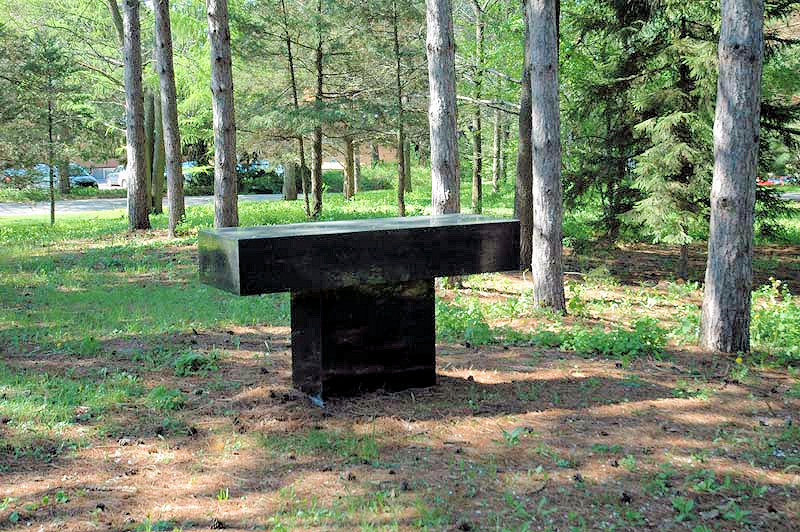 The following month the razing of the chapel began and continued to the beginning of June as Heritage Movers began mobilizing to move the House. Moving the House required three moves, first to the east to provide space for part of the new foundation, then north and finally west to its present location. Lost in the demolition and move was the mosaic behind the altar, the organ, and most of the stained-glass windows. (Footnote:
Bill Mueller, email, 30 August 2021. Bill took hundreds of photos of the demolition and move of the House from February of 2012 to April, 2013 which for a time were online. He graciously put them on a CD for me and should anyone be looking for somethings specific please contact me.
)
One benefit of the project deal was a major upgrade of the HVAC system of the House. (Footnote:
Tom Ferguson, email, 8/28/2021.
)
The following month the razing of the chapel began and continued to the beginning of June as Heritage Movers began mobilizing to move the House. Moving the House required three moves, first to the east to provide space for part of the new foundation, then north and finally west to its present location. Lost in the demolition and move was the mosaic behind the altar, the organ, and most of the stained-glass windows. (Footnote:
Bill Mueller, email, 30 August 2021. Bill took hundreds of photos of the demolition and move of the House from February of 2012 to April, 2013 which for a time were online. He graciously put them on a CD for me and should anyone be looking for somethings specific please contact me.
)
One benefit of the project deal was a major upgrade of the HVAC system of the House. (Footnote:
Tom Ferguson, email, 8/28/2021.
)
Thanks to long-time SFH organist Bill Mueller, we have hundreds of photos of the demolition and move of the House in 2012 and 2013. Here are but three of them. Click to enlarge.
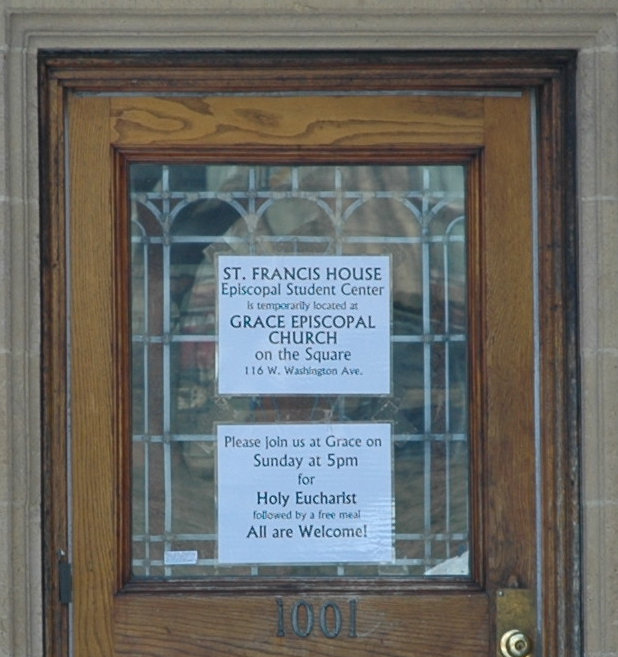 Into the mess came the Rev. Jonathan Melton who took the chaplaincy in the summer of 2012, holding services for Episcopal Students at Grace Episcopal on the square in Madison, kicking off September 9th. He had no permanent home on the campus for students and was told by colleagues that it would take years to reassemble a community around St. Francis House. He kept office hours in coffee shops and met students for dinner on Thursdays at the Rathskeller in the Student Union. Getting the community back together was hard work that paid off. In 2014 Fr. Melton was awarded the Episcopal Church’s Distinguished Leadership award for work with young adults and campus ministry, spelled out by the Church’s missioner at the time: “the Rev. Jonathan Melton has made incredible strides in re-establishing a strong ministry at the University of Wisconsin, Madison. His impressive use of social media is coupled with a knack for community building that is helping college students connect with the Episcopal Church.” He has a wonderful description of these times on his blog post in August of 2016,
“A Badgerland Biography: Glimpses into My First Four Years with the St. Francis House Community.” It would be redundant to include much of that here, but I would urge anyone interested in this period to check it out - linked above.
Into the mess came the Rev. Jonathan Melton who took the chaplaincy in the summer of 2012, holding services for Episcopal Students at Grace Episcopal on the square in Madison, kicking off September 9th. He had no permanent home on the campus for students and was told by colleagues that it would take years to reassemble a community around St. Francis House. He kept office hours in coffee shops and met students for dinner on Thursdays at the Rathskeller in the Student Union. Getting the community back together was hard work that paid off. In 2014 Fr. Melton was awarded the Episcopal Church’s Distinguished Leadership award for work with young adults and campus ministry, spelled out by the Church’s missioner at the time: “the Rev. Jonathan Melton has made incredible strides in re-establishing a strong ministry at the University of Wisconsin, Madison. His impressive use of social media is coupled with a knack for community building that is helping college students connect with the Episcopal Church.” He has a wonderful description of these times on his blog post in August of 2016,
“A Badgerland Biography: Glimpses into My First Four Years with the St. Francis House Community.” It would be redundant to include much of that here, but I would urge anyone interested in this period to check it out - linked above.
Fr. Melton left in 2019 to take up the post of Associate Priest in Texas, but not before, in 2016, he organized a 100-year anniversary get-together at the House of former and current members of the community. That was announced by a YouTube video at https://youtu.be/7Tu6JVQm3T8 and in the sidebar of that video are several videos taken at the time of community members speaking of their experiences at the House. Following Fr. Melton’s departure, the House was ministered by the Rev. Donald Fleischman, the rector of St. Luke’s in Madison. At the beginning of September, 2021, it was announced that the Rev. Roberta (Bobbi) Kraft would be the new chaplain, assuming duties at the beginning of October.
Addendum - the Organ
The original organ as expanded in the 1964 chapel, was lost in the demolition and move. It was for decades an important feature of the House and is memorialized here. As described in the first part, it was built by the M.P. Möller company. Fr. Abel made sure that the organ was included, and upgraded, in the 1964 addition. Working with local organ builder, H. Frederick Fuller, the organ saw the addition of a three rank Positiv Division and the replacement of some of the dated pipework on the main chest. The console was moved to the main floor and the main pipe work was relocated to the former choir loft on the second floor. The new pipe work was supplied by the Schantz organ company of Orville, Ohio and the Positiv was installed on the back wall of the chapel. While no pictures of the organ in its original location in the loft are known, the following pictures, all courtesy of Bill Mueller, the organist from 1963 to 1985, show it in the now demolished church. The pictures are flanked top and bottom by an image of the stained-glass windows stitched together that stretched the south side of the chapel. The glass on the north side was plain glass.


Footnotes: Note:links to newspapers.com images need a subscription.
Footnotes:
About me - and a disclaimer
As written at the end of the first part of this history, my association with St. Francis House was roughly from 1963 to 1975, at which point I left Madison with my bride and young son. We had a happy life in the Miller Beach neighborhood of Gary, Indiana for 36 years until my wife died of cancer in 2011. My association with the House during those years is no doubt why this unofficial history is weighted towards those years. I’m sure that many wonderful and enlightening events occurred either side of those years, but I put this history together using newspapers, personal experience, and whatever else I could find – newspapers tend to focus on the political and dramatic. I welcome any additions or corrections to this history, which, I repeat, is unofficial and not connected with the current administration of the House.
Acknowledgements
The name Bill Mueller pops up in both parts of this history. Thanks to Bill for providing the great pictures of the 1964 church, its demolition and the move of the House. As organist from 1963 to 1985 I’m also indebted to him for his knowledge of the organ. A friend since 1963 he married another friend of mine, the late Rev. Susan Mueller, may she rest in peace. I’d also like to thank the Rev. Melissa Wilcox and the Rev. Thomas Ferguson for their emails clarifying the succession of chaplains following the Rev. Lund.
Page created September, 2021
© Text copyright: Steve Spicer
Feel free to contact me about this page.
